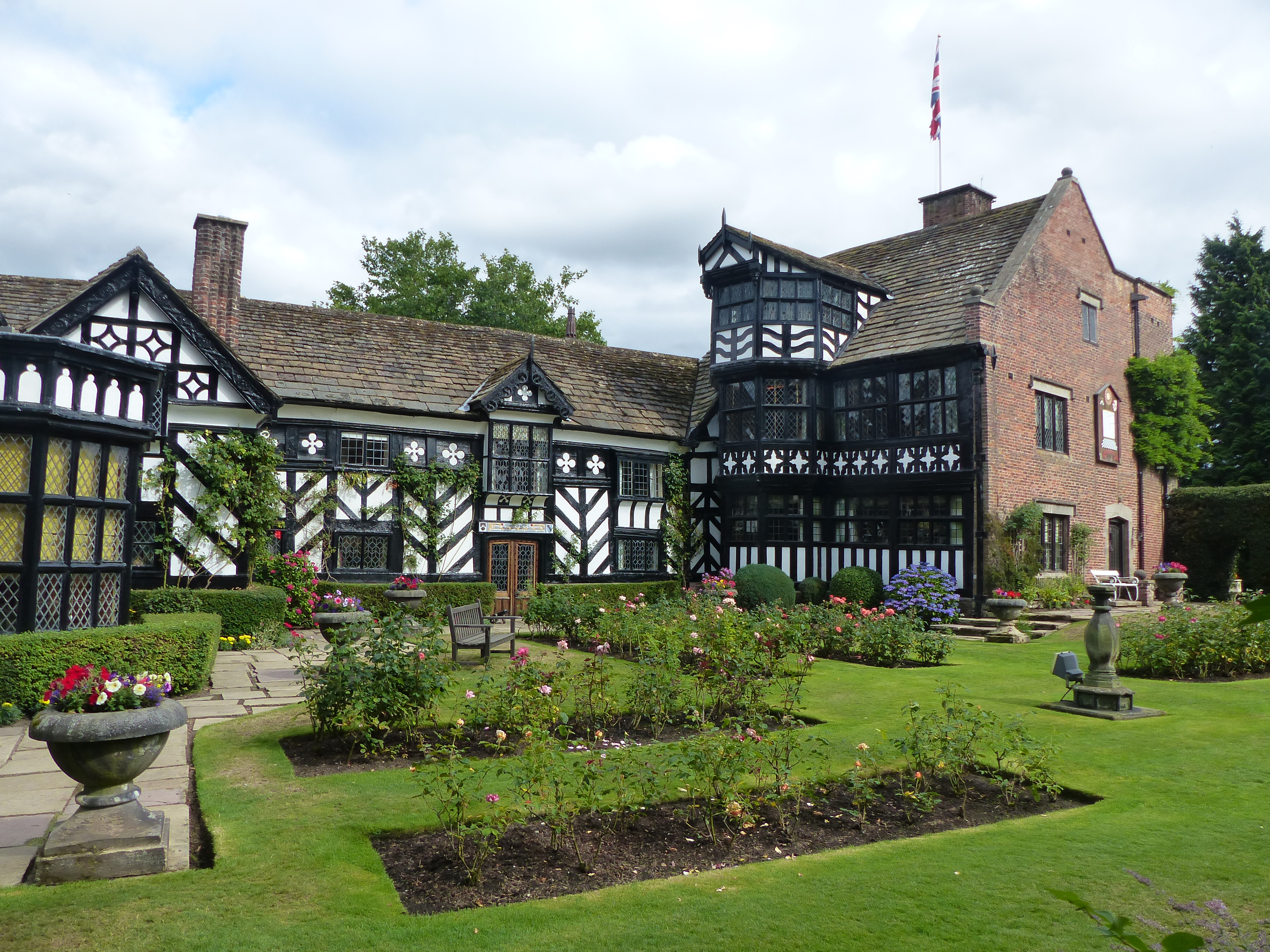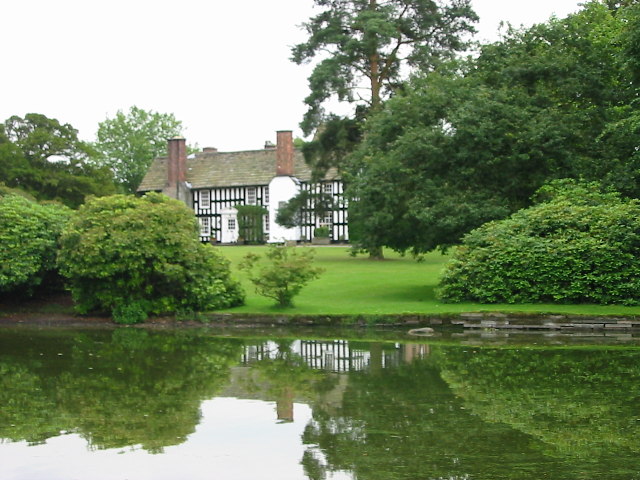|
Gawsworth New Hall
Gawsworth New Hall is a country house in the village of Gawsworth, Cheshire, England. It is recorded in the National Heritage List for England as a designated Grade II* listed building. The house was begun by Lord Mohun in 1707 but abandoned after he was killed in a duel with the Duke of Hamilton in 1712. Later additions and alterations were made including those to the designs of Sir Hubert Worthington in 1914. Late-19th-century residents of the house included William Taylor Birchenough,Kelly's Cheshire Directory, Seventh Edition, 1906, p.333 a Macclesfield silk manufacturer and partner in the Macclesfield firm John Birchenough & Son, who was the brother of Sir Henry Birchenough. W.T. Birchenough lived in the house with his wife Jane Birchenough, daughter of Richard Peacock MP and their four children. His youngest son, also William Taylor Birchenough, was a pioneering aviator and test pilot. The house is built in red brick with a stone slate roof. It has two store ... [...More Info...] [...Related Items...] OR: [Wikipedia] [Google] [Baidu] |
Gawsworth
Gawsworth is a civil parish and village in the unitary authority of Cheshire East and the ceremonial county of Cheshire, England. The population of the civil parish at the 2011 census was 1,705. It is one of the eight ancient parishes of Macclesfield Hundred. Twenty acres of the civil parish were transferred to Macclesfield civil parish in 1936 The country houses Gawsworth Old Hall, Gawsworth New Hall and Gawsworth Old Rectory are in the village. The authors of the Cheshire volume of the '' Buildings of England'' series state: There is nothing in Cheshire to compare with the loveliness of Gawsworth: three great houses and a distinguished church set around a descending string of pools, all within an enigmatic large-scale formal landscape. A wood near the village known as Maggotty Wood is the burial place of the eighteenth-century dramatist Samuel "Maggotty" Johnson. His ghost is reputed to haunt the wood. Governance Gawsworth Parish Council consists of 9 elected Councillors i ... [...More Info...] [...Related Items...] OR: [Wikipedia] [Google] [Baidu] |
Henry Birchenough
Sir John Henry Birchenough, 1st Baronet, (7 March 1853 – 12 May 1937) was an English businessman and public servant. Early life and education Birchenough was born in Macclesfield, Cheshire, the second son of John Birchenough, a silk manufacturer. He was educated firstly at Strathmore House, Southport, then subsequently at the University of Oxford, University College, London (BA, 1873; MA, 1876). It was at University College London that he became close friends with Leonard Montefiore, the Jewish philanthropist. This friendship was described in the introduction to Montefiore's posthumous "Essays and Letters" as ''"the greatest friendship of his life- a friendship which was marred by no reserves and subject to no fluctuations but continued from its first commencement to Montefiore's death"''. Latterly Birchenough attended the École Libre des Sciences Politiques, Paris. According to an obituary published by Reuters at the time of his death it was whilst at Paris that he "''obta ... [...More Info...] [...Related Items...] OR: [Wikipedia] [Google] [Baidu] |
Country Houses In Cheshire
A country is a distinct part of the world, such as a state, nation, or other political entity. It may be a sovereign state or make up one part of a larger state. For example, the country of Japan is an independent, sovereign state, while the country of Wales is a component of a multi-part sovereign state, the United Kingdom. A country may be a historically sovereign area (such as Korea), a currently sovereign territory with a unified government (such as Senegal), or a non-sovereign geographic region associated with certain distinct political, ethnic, or cultural characteristics (such as the Basque Country). The definition and usage of the word "country" is flexible and has changed over time. ''The Economist'' wrote in 2010 that "any attempt to find a clear definition of a country soon runs into a thicket of exceptions and anomalies." Most sovereign states, but not all countries, are members of the United Nations. The largest country by area is Russia, while the smallest i ... [...More Info...] [...Related Items...] OR: [Wikipedia] [Google] [Baidu] |
Houses Completed In 1707
A house is a single-unit residential building. It may range in complexity from a rudimentary hut to a complex structure of wood, masonry, concrete or other material, outfitted with plumbing, electrical, and heating, ventilation, and air conditioning systems.Schoenauer, Norbert (2000). ''6,000 Years of Housing'' (rev. ed.) (New York: W.W. Norton & Company). Houses use a range of different roofing systems to keep precipitation such as rain from getting into the dwelling space. Houses may have doors or locks to secure the dwelling space and protect its inhabitants and contents from burglars or other trespassers. Most conventional modern houses in Western cultures will contain one or more bedrooms and bathrooms, a kitchen or cooking area, and a living room. A house may have a separate dining room, or the eating area may be integrated into another room. Some large houses in North America have a recreation room. In traditional agriculture-oriented societies, domestic animals such as ... [...More Info...] [...Related Items...] OR: [Wikipedia] [Google] [Baidu] |
Grade II* Listed Buildings In Cheshire
The county of Cheshire is divided into four unitary authorities: Cheshire West and Chester, Cheshire East, Warrington, and Halton. As there are 390 Grade II* listed buildings in the county, they have been split into separate lists for each unitary authority. * Grade II* listed buildings in Cheshire West and Chester * Grade II* listed buildings in Cheshire East * Grade II* listed buildings in Warrington * Grade II* listed buildings in Halton (borough) See also * Grade I listed buildings in Cheshire The county of Cheshire is divided into four unitary authorities: Cheshire West and Chester, Cheshire East, Warrington, and Halton. As there are 142 Grade I listed buildings in the county they have been split into separate lists for each unit ... {{DEFAULTSORT:Grade II listed buildings in Cheshire * * ... [...More Info...] [...Related Items...] OR: [Wikipedia] [Google] [Baidu] |
Listed Buildings In Gawsworth
Gawsworth is a civil parish in Cheshire East, England. It contains 20 buildings that are recorded in the National Heritage List for England as designated listed buildings. Of these, three are listed at Grade I, the highest grade, two are listed at Grade II*, the middle grade, and the others are at Grade II. Apart from the village of Gawsworth, the parish is rural. The most important buildings in the parish, all listed at Grade I, are Gawsworth Old Hall and associated structures, St James' Church, also with associated structures, and the Old Rectory. Listed at Grade II* are Gawsworth New Hall and an associated barn. The Macclesfield Canal runs through the parish, and there are three listed structures associated with this, two bridges and a milestone. The other listed buildings are houses, farm buildings, a grave, a public house, a war memorial, and a boundary stone. Key Buildings See also *Listed buildings in Bosley * Listed buildings in Henb ... [...More Info...] [...Related Items...] OR: [Wikipedia] [Google] [Baidu] |
Grade II* Listed Buildings In Cheshire East
There are over 20,000 Grade II* listed buildings in England. This page is a list of these buildings in the unitary authority of Cheshire East. Listed buildings Notes See also *Grade I listed buildings in Cheshire East *Grade II* listed buildings in Cheshire The county of Cheshire is divided into four unitary authorities: Cheshire West and Chester, Cheshire East, Warrington, and Halton. As there are 390 Grade II* listed buildings in the county, they have been split into separate lists for each un ... ** Grade II* listed buildings in Cheshire West and Chester ** Grade II* listed buildings in Cheshire East ** Grade II* listed buildings in Warrington ** Grade II* listed buildings in Halton (borough) References Notes External links {{DEFAULTSORT:Grade II listed buildings in Cheshire ... [...More Info...] [...Related Items...] OR: [Wikipedia] [Google] [Baidu] |
Gawsworth Old Hall
Gawsworth Old Hall is a Grade I listed country house in the village of Gawsworth, Cheshire, England. It is a timber-framed house in the Cheshire black-and-white style. The present house was built between 1480 and 1600, replacing an earlier Norman house. It was probably built as a courtyard house enclosing a quadrangle, but much of it has been demolished, leaving the house with a U-shaped plan. The present hall was owned originally by the Fitton family, and later by the Gerards, and then the Stanhopes. Since the 1930s it has been in the possession of the Richards family. Raymond Richards collected a number of items from other historic buildings and incorporated them into the hall. Notable residents have included Mary Fitton, perhaps the " Dark Lady" of Shakespeare's sonnets, and Samuel "Maggoty" Johnson, a playwright described as the last professional jester in England, whose grave is nearby in Maggoty Wood, a small National Trust woodland. In 1712 a dispute about t ... [...More Info...] [...Related Items...] OR: [Wikipedia] [Google] [Baidu] |
William Taylor Birchenough
William Taylor Birchenough (1891–1962) was a pioneering British aviator and test pilot. Family Birchenough was born at Gawsworth New Hall, the third son of William Taylor Birchenough, a silk Manufacturer and Justice of Peace, for the County of Chester, and his wife Jane Birchenough, daughter of Richard Peacock MP. His grandfather was John Birchenough, a Mayor of Macclesfield and he was a nephew of Sir Henry Birchenough. Fowler's Match At Eton College he was a proficient cricketer and played in the famous Fowler's Match in 1910 against Harrow School which was described in an article in The Spectator marking the match's centenary, as "what might just be the greatest cricket match of all time". Aviation career After leaving Eton Birchenough developed an interest in flying and joined the Grahame-White training school on 7 February 1913. Over the following months he carried out his training under the instruction of Marcus Dyce Manton before being awarded his aviator's certificate ... [...More Info...] [...Related Items...] OR: [Wikipedia] [Google] [Baidu] |
Richard Peacock
Richard Peacock (9 April 1820 – 3 March 1889) was an English engineer, one of the founders of locomotive manufacturer Beyer, Peacock and Company. Early life and education Born in Swaledale, Yorkshire, Richard Peacock was educated at Leeds Grammar School. At 14 he left to be apprenticed at Fenton, Murray and Jackson in Leeds. Career Reflecting a burgeoning industry that had barely started a decade beforehand, the Leeds and Selby Railway Company appointed Peacock in 1838, aged 18, as a locomotive superintendent. When the firm was acquired by the York and North Midland Railway in 1840, he worked under Daniel Gooch at Swindon, but left reputedly to escape Gooch's wrath. In 1841 he became the locomotive superintendent of the Sheffield, Ashton-under-Lyne and Manchester Railway, which became the Manchester, Sheffield and Lincolnshire Railway Company from 1847. In this role he was responsible for founding the Gorton locomotive works for the company. He left shortly b ... [...More Info...] [...Related Items...] OR: [Wikipedia] [Google] [Baidu] |
John Birchenough
John Birchenough JP (1 November 1825 – 7 May 1895) was an English silk manufacturer and local politician in Macclesfield, Cheshire in the nineteenth century. He was the head of the Macclesfield silk manufacturing firm Birchenough and Sons with mills at Park Lane, Prestbury Road and Henderson Street in Macclesfield. He was a Wesleyan Methodist and was a supporter of local charities in Macclesfield. Birchenough was a member of the Macclesfield Town Council for nearly forty years during a time of great transformation for the town when many public works – such as the waterworks, the cemetery, enlargement of the Town Hall, extensions at the gasworks, and the transformation of the muddy streets into cleanly paved, and hard macadamized roads – were carried out.Macclesfield Chronicle, 11 May 1895 Birchenough was a Liberal Unionist and served as Mayor of Macclesfield Town in 1875–76. His portrait hangs in Macclesfield old Town Hall. Silk industry Birchenough started his caree ... [...More Info...] [...Related Items...] OR: [Wikipedia] [Google] [Baidu] |
Cheshire
Cheshire ( ) is a ceremonial and historic county in North West England, bordered by Wales to the west, Merseyside and Greater Manchester to the north, Derbyshire to the east, and Staffordshire and Shropshire to the south. Cheshire's county town is the cathedral city of Chester, while its largest town by population is Warrington. Other towns in the county include Alsager, Congleton, Crewe, Ellesmere Port, Frodsham, Knutsford, Macclesfield, Middlewich, Nantwich, Neston, Northwich, Poynton, Runcorn, Sandbach, Widnes, Wilmslow, and Winsford. Cheshire is split into the administrative districts of Cheshire West and Chester, Cheshire East, Halton, and Warrington. The county covers and has a population of around 1.1 million as of 2021. It is mostly rural, with a number of towns and villages supporting the agricultural and chemical industries; it is primarily known for producing chemicals, Cheshire cheese, salt, and silk. It has also had an impact on popular cult ... [...More Info...] [...Related Items...] OR: [Wikipedia] [Google] [Baidu] |




